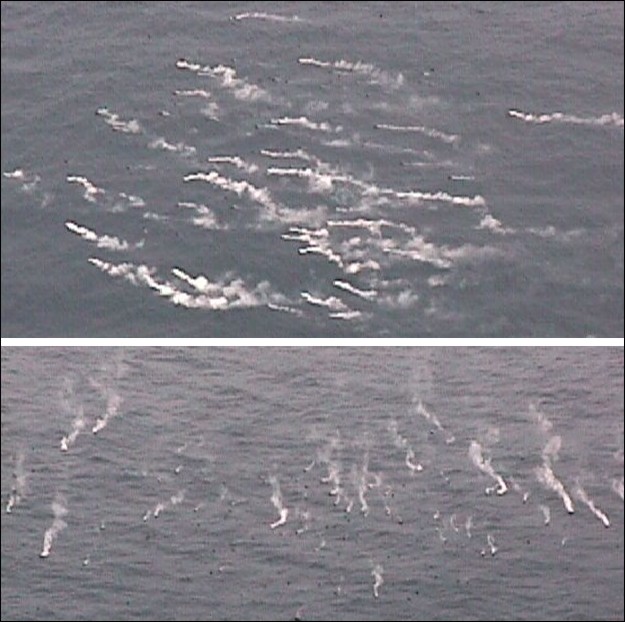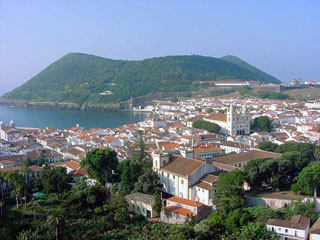Report on Terceira (Portugal) — January 1999
Bulletin of the Global Volcanism Network, vol. 24, no. 1 (January 1999)
Managing Editor: Richard Wunderman.
Terceira (Portugal) Submarine eruption west of Terceira produces floating lava blocks
Please cite this report as:
Global Volcanism Program, 1999. Report on Terceira (Portugal) (Wunderman, R., ed.). Bulletin of the Global Volcanism Network, 24:1. Smithsonian Institution. https://doi.org/10.5479/si.GVP.BGVN199901-382050
Terceira
Portugal
38.73°N, 27.32°W; summit elev. 1023 m
All times are local (unless otherwise noted)
A small seismic crisis during November 1998 was monitored by the Azores Seismological Surveillance System (SIVISA). It was centered W of Terceira Island on the E of the so-called Graciosa Trough [38.783°N, 27.483°W; submarine vent at -500 m]. After four days of major activity seismicity decreased and remained at normal levels until 18 December; then, a few microseisms were registered by SIVISA and white vapor columns were reported by fishermen to be rising from the sea 8 km W of Terceira island. These phenomena were discontinuous but persisted until the night of 23 December when local residents observed orange lights several miles W of Terceira.
Although no unusual seismicity was noticed in the following interval, on 8 January fishermen again reported white vapor columns on the sea. Scientists from the Center of Volcanology of Azores University (CVUA) using a helicopter of the Portuguese Air Force took the first pictures of the phenomenon (figure 1). Lava blocks reaching a maximum of 3 m in length rose gently to the surface where they floated for a few minutes. White steam columns resulting from contact between hot lava blocks and seawater were observed, rising about 10 m above the surface of the sea. During the night the same activity was observed from the W coast of Terceira island and six different areas of incandescent, dispersed lava blocks were identified along a NE-SW axis. Activity continued at the same level until 13 January after which only intermittent short-period events were observed.
 |
Figure 1. Two views of the eruption site as photographed by João Gaspar from a helicopter during an overflight on 8 January 1999. Courtesy of CVUA. |
On the morning of 10 February three spots of white steam suddenly rose ~70 m into the air at a point 8 km from the coast. The steam was seen from land. That afternoon scientists from CVUA with personnel of the Azores Civil Protection Force retrieved the first rock sample from the eruption.
Lava produced by this submarine fissure eruption was basaltic, showing phenocrysts of olivine, pyroxene, and plagioclase in a highly vesicular groundmass. Analysis of the sample suggested that material rose from the sea bottom as hot lava balloons, lost gas from their interiors at the surface, and then sank. Seismic activity and physical and chemical parameters of waters and fumarolic gases continue to be monitored.
Another submarine eruption took place in this general location in June 1867, but closer to land. This is thought to be the first submarine eruption in the Atlantic in more than 30 years that has brought products to the sea surface. The name "Serrata" has been tentatively given to this feature.
Geological Summary. Terceira Island contains multiple stratovolcanoes constructed along a prominent ESE-WNW fissure zone that cuts across the island. Historically active Santa Barbara volcano at the western end of the island is truncated by two calderas, the youngest of which formed about 15,000 years ago. Comenditic lava domes fill and surround the caldera. Pico Alto lies north of the fissure zone in the north-central part of the island and contains a Pleistocene caldera largely filled by lava domes and lava flows. Guilherme Moniz caldera lies along the fissure zone immediately to the south, and 7-km-wide Cinquio Picos caldera is at the SE end of the island. Historical eruptions have occurred from Pico Alto, the fissure zone between Pico Alto and Santa Barbara, and from submarine vents west of Santa Barbara. Most Holocene eruptions have produced basaltic-to-rhyolitic lava flows from the fissure zone.
Information Contacts: João Luís Gaspar and Nicolau Wallenstein, Center of Volcanology of the Azores University (CVAU), Departamento de Geociencias, Rua da Mae de Deus, 9502 Ponta Delgada, Azores, Portugal (URL: http://www.uac.pt/).

